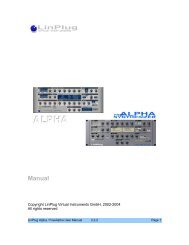SaxLab Manual - LinPlug Virtual Instruments
SaxLab Manual - LinPlug Virtual Instruments
SaxLab Manual - LinPlug Virtual Instruments
You also want an ePaper? Increase the reach of your titles
YUMPU automatically turns print PDFs into web optimized ePapers that Google loves.
Glossary<br />
Amplifier: A signal processing device that changes the amplitude, and<br />
hence the loudness, of a signal.<br />
Amplitude: With respect to sound, the peak amount of variation above and<br />
below atmospheric pressure caused by the compression and<br />
rarefaction components of a sound. Amplitude indicates the<br />
amount of energy in a sound and generally correlates with our<br />
perception of “loudness”. The term can also apply to any signal,<br />
hence the term “Amplitude Envelope” which is used to describe<br />
the way a synthesizer’s loudness varies over time when a note<br />
is played.<br />
Chorus: The creation of the perception of multiple unison voices from a<br />
single voice.<br />
Crossfade: The process of mixing two audio signals together by increasing<br />
the amplitude of one as the amplitude of the other is decreased.<br />
Effect: A signal processing device that changes some aspect of the<br />
input signal. An enormous number of different effect types are<br />
available. These include Chorus (which produces a thickening of<br />
the signal), Delay (adding echoes to the signal) and Distortion<br />
(which changes the shape of the waveform usually adding<br />
overtones).<br />
Envelope: A time-varying signal used to control the development of another<br />
signal after it has been triggered. Envelopes are most often<br />
used for controlling a signal's amplitude. The shape of the<br />
envelope is determined by the number of control parameters.<br />
Usually four parameters are available: Attack Time, Decay Time,<br />
Sustain Level and Release Time.<br />
Filter: A signal processing device that suppresses or "filters" out<br />
specific parts of a signal's frequency spectrum. Numerous types<br />
of filter are used in audio synthesis. These include Low Pass,<br />
High Pass, Band Pass and Notch. The tone controls on a stereo<br />
amplifier are one example of an audio filter.<br />
LFO: An LFO or "Low Frequency Oscillator" is a periodic signal<br />
source (usually below audio frequency range) used to modulate<br />
another signal parameter. An LFO can be used for a variety of<br />
effects including vibrato (by modulating the instrument’s pitch)<br />
and tremolo (by modulating the instrument’s amplitude).<br />
Modulation: The variation of one parameter by another. For example, a<br />
signal’s frequency can be “modulated” by an LFO (Low<br />
Frequency Oscillator) in which case vibrato is produced.<br />
<strong>LinPlug</strong> <strong>SaxLab</strong> User Guide 2.0.3<br />
36












